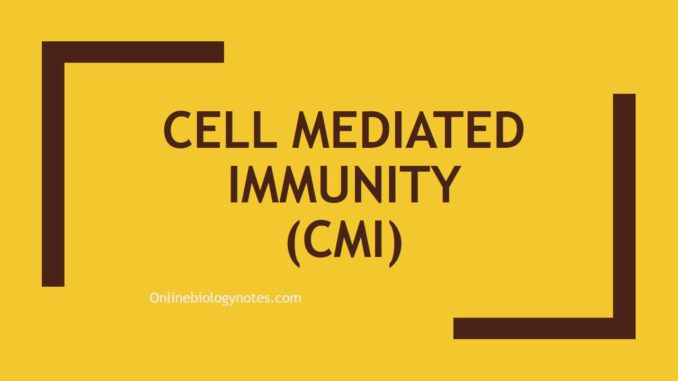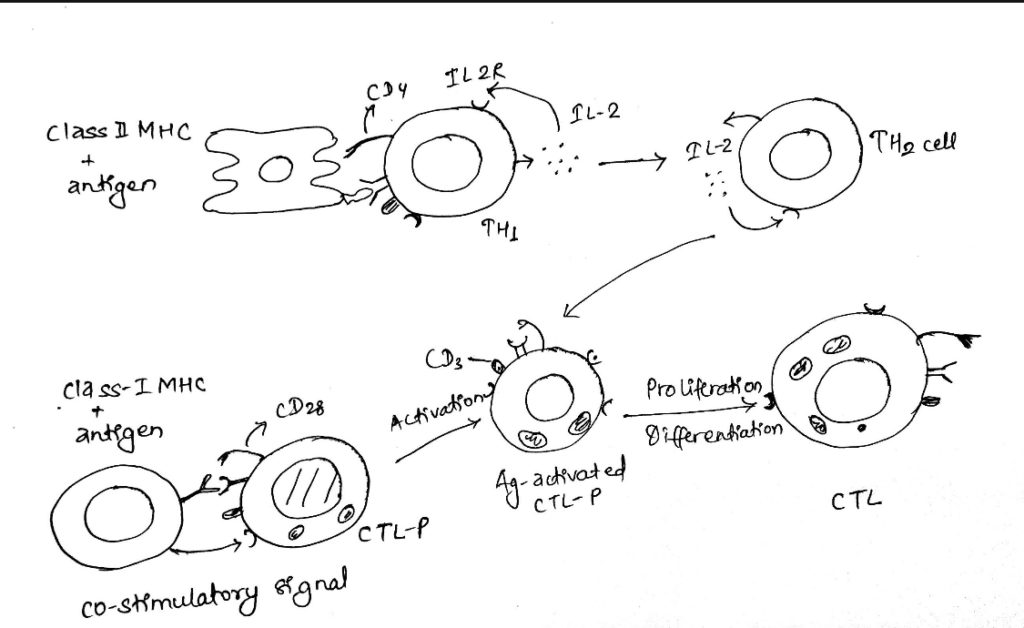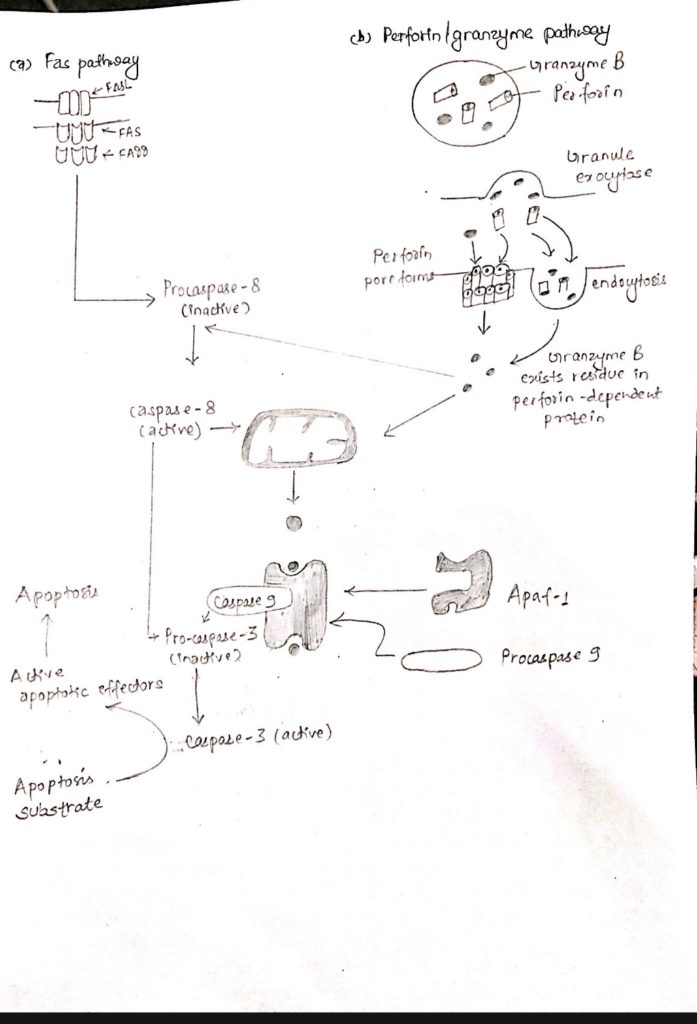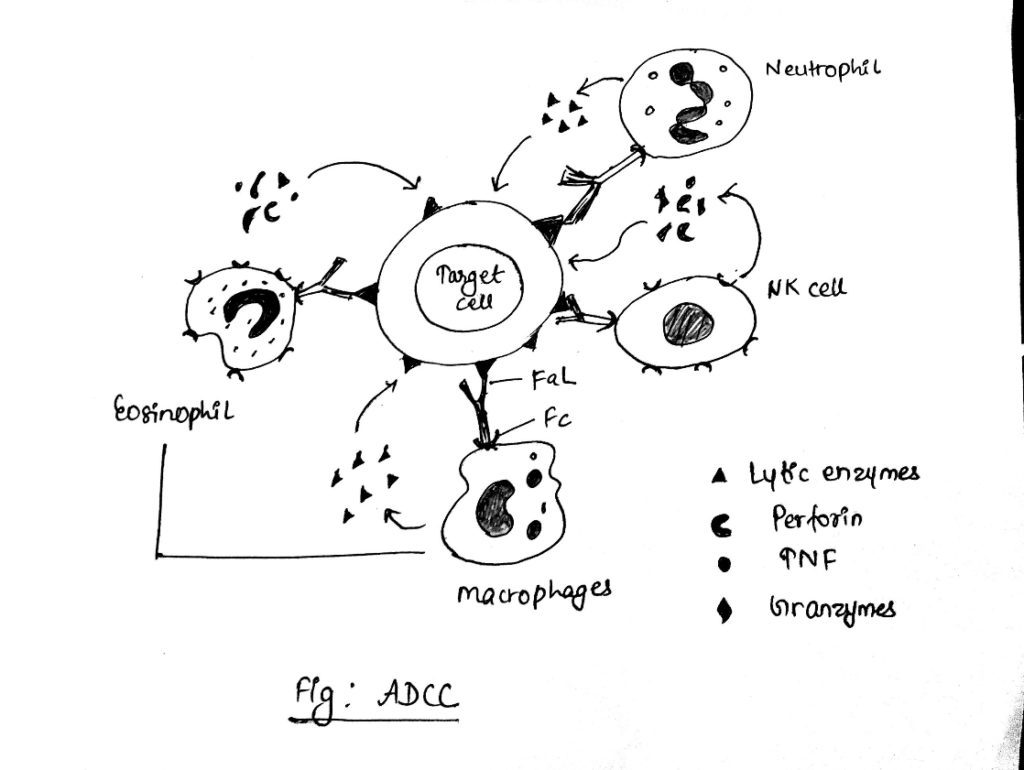
Cell Mediated immune response
- Cell mediated immune response (CMI) is the host defense that are mediated by Antigen specific T-cells and various non-specific cells of immune system.
- It protects against intracellular bacteria, virus and cancer and is responsible for graft rejection.
- Both the antigen specific and non-specific cells can contribute to CMI.
- Ag-specific cells include CD8+ cytotoxic T-lymphocytes (Tc or CTL) and cytokine secreting CD4+ TH cells that mediate delayed type hypersensitivity.
- The non-specific cells include NK cells and non-lymphoid cells types such as macrophages, neutrophils and eosinophils.
- The activities of both specific and non-specific cytotoxic components of immunity depends on effective local concentrations of various cytokines.
Types of Cell mediated immunity on the basis of Effector response:
- Cell mediated immune responses can be divided into two major categories according to the different effector population that are mobilized.
- i.e. 1) Ag-specific CMI 2) Non-specific CMI
i) Antigen specific Cell Mediated Immunity: Steps
- The Antigen (Ag) specific CMI response includes the cytotoxic T lymphocytes (CTLs) as effector population.
Step I: Activation of T-cells or generation of effective CTLs
- Nerve Tc cells or generation of killing target cells only after a naïve T-cell has been activated will differentiate into a functional CTL with cytotoxic activity.
- The activated of T-cell into CTL requires at least three sequential signals.
- An antigen specific signal transmitted by TCR complex upon recognition of a peptide-class-I MHC molecule complex on an APC.
- A co-stimulatory signal transmitted by the CD28 and B7 interaction of Tc cells and APC.
– This signal stimulates the expression of IL-2R and lesser amount of IL-2 on Tc cell. - A signal induced by the interaction of IL-2 with the high affinity IL-2R resulting in the proliferation and differentiation of antigen activated Tc cells into effector CTLs which consist of 65kDa monomer of protein called perforin and several serine proteases called granzymes.

Step II: Lysis of target cell in Antigen mediated cell immunity:
- The process of cell lysis begins when TCR-CD3 complex on CTL recognizes antigen associated with class-I MHC on the target cell.
- After this antigen-specific recognition, the integrin receptor LFA-I on the CTL binds to the ICAM on the target cell resulting in the formation of a conjugate.
- Ag mediated CTL activation converts LFA-I from low affinity state to high affinity state.

Stages in Antigen specific Cell mediated killing of target cells
i. Membrane attack:
- Immediately after the formation of CTL-target cell conjugate, golgi stacks and storage granules concentrate near the junction with the target cell.
- The perforin monomers and granzymes protease are then released from the granules by exocytosis into the space at junction between the two cells.
- Then the granzymes get entry into the target cell.
- There are two ways of entry of granzymes into the target cells.
- When the perforins contact the target membrane, they undergo a conformational change, exposing an amphipathic domain that inserts into the target cell membrane, then polymerize in the presence of Ca2+ to form cylindrical pores with an internal diameter of 5-20nm. After formation, granzymes enter through the pores into target cell.
- Many target cells have receptors known as mannose-6-phsophate on their surface that bind to granzyme B. Granzyme B-mannose-6-phosphate receptors complexes are internalized and appear inside the vesicles. Perforin internalizes at same time, then forms pore that release granzyme B from the vesicles into the cytoplasm of the target cell.
ii. Cytotoxic T-lymphocytes (CTL) dissociation:
- The LFA-I persists in the high affinity state for only 5-10 minutes after antigen mediated activation and then it returns to the low affinity state.
- This downshift in LFA-I affinity facilitates dissociation of CTL from the target cell.
iii. Target cell destruction:
- Once it enters the cytoplasm of the target cells, granzyme B initiates cascade of reaction that results in the fragmentation of target cell DNA into 200bp oligomer.
- This type of DNA fragmentation is typical of apoptosis.
- Granzymes which are protease don’t directly mediate DNA fragmentation, rather, they activate an apoptotic pathway within the target cell.
- Some, CTL lack perforin and granzymes B.
- In these cases, cytotoxicity is mediated by FAs.
- The FAs ligand, FasL is found on the membrane of CTL and interaction of FasL with FAs on target cell triggers apoptosis.
iv. Apoptosis:
- The feature of cell death by apoptosis is the involvement of the caspase family.
- Normally, caspases are present in the cell as inactive pro-enzyme, procaspase which requires proteolytic cleavage for conversion to active form.
- More than a dozen caspases have been found each with its own specificity.
- Cleavage of procaspase produces activator (active initiator caspase), which cleaves other procaspases, thereby activating their proteolytic activity.
- CTL uses granzyme and FasL to initiate caspase cascade in their target.
- Granzymes introduced into target cell mediate proteolytic event that activate an initiator caspase.
- Similarly, the engagement of Fas and FasL causes the activation of an initiator caspase in target cell.
- Fas is associated with FADD which in turn associates with procaspase, type of caspase 8.
- On Fas crosslinking, procaspase 8 is converted to caspase 8 and initiates an apoptotic caspase cascade.

ii) Non-specific Cell Mediated Immunity:
- Non-specific CMI response includes NK cells, macrophage, neutrophil and eosinophil.
- These cells can use antibody as receptor to recognize and for billing the target cells.
- NK cells appear to kill tumor cells and virus infected cells by processes similar to those employed by CTLs.
- NK cells possess FasL on their surface and subsequently induce death in Fas-bearing target cells.
- The cytoplasm of NK cell has many granules containing perforin and granzymes unlike CTL, which must be activated before granules appear.
- NK cells are constitutively cytotoxic and always have granules.
- After an NK cell adheres to target cell, degranulation occurs with release of perforin and granzymes at the junctions of interacting cells.
- Perforin and granzymes play same role in NK-mediated killing of target cell by apoptosis as they do in CTL-mediated killing process.
Antibody dependent Cellular Cytotoxicity (ADCC):
- A number of cells that have cytotoxic potential express membrane receptors for the Fc region of the antibody molecule when antibody is specially bound to a target cell, cells bearing the Fc receptors can bind to a target cell, subsequently causing lysis of the target cell.
- Although, the cytotoxic cells are non-specific for antigen, the specificity of antibody directs them to the specific target cell. This type of cytotoxicity is known as ADCC.
- Target cell killing by ADCC appears to involve a no. of different cytotoxic mechanism but not complement mediated lysis.
- When macrophage, neutrophil, eosinophil bind to target cell by Fc receptors, they become more active metabolically, as a result, the level of lytic enzymes in their cytoplasmic lysosome or granule increases.
- Release of these lytic enzymes of side of Fe mediated contact results in the damage of target cell.
- In addition, activated monocytes NK cells and macrophages secrete TNP that have cytotoxic effect on the bound target cell.
- Since NK cells and eosinophils contain perforin in the cytoplasmic granules, their target killing also involves perforin mediated damage.

